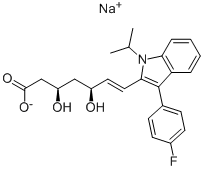Description
Fluvastatin sodium is the fourth HMG-CoA reductase inhibitor to reach the market
as a dietary adjunct for lowing total and low-density lipoprotein (LDL) cholesterol.
Fluvastatin sodium is the first totally synthetic inhibitor of its class and has more
potent effects on reducing serum total and LDL cholesterol and serum triglyceride
levels than compactin or lovastatin. Moreover, fluvastatin exhibits a unique set of
pharmacological properties including a biopharmaceutical profile most consistent
with hepatoselectivity. It has been reported to be well tolerated and to exhibit a
safety profile superior to other agents of its class. The main mechanism by which
HMG-CoA reductase inhibitors lower plasma cholesterol has been suggested to be
up-regulation of hepatocellular LDL-receptor expression and enhancement of
receptor-mediated clearance and catabolism of LDL cholesterol.
Originator
Sandoz (Switzerland)
Definition
ChEBI: (3R,5S)-fluvastatin sodium is an organic sodium salt resulting from the replacement of the proton from the carboxy group of (3R,5S)-fluvastatin by a sodium ion. It is an organic sodium salt and a statin (synthetic). It contains a (3R,5S)-fluvastatin(1-). It is an enantiomer of a (3S,5R)-fluvastatin sodium.
Manufacturing Process
164 ml (235.1 g, 2.04 moles) of chloroacetyl chloride is added over a 50 min period to a mixture of 400 ml (410 g, 4.22 moles) of fluorobenzene and 300.0 g (2.25 moles) of anhydrous aluminum chloride stirred at 75°C under nitrogen. The reaction mixture is stirred at 80°C under nitrogen for 1 h, cooled to 50°C, 500 ml of fluorobenzene is added, and the reaction mixture is cooled to 0°C and gradually (over a 30 min period) siphoned into 1 L of 6 N hydrochloric acid stirred at 0°C. (The temperature of the aqueous acid is maintained at or below 25°C throughout the addition). The quenched, acidified reaction mixture is stirred for 15 min, and the aqueous phase is separated and extracted with 350 ml of fluorobenzene. The two organicphases are combined and washed twice with 500 ml portions of 3 N hydrochloric acid and once with 500 ml of water. The fluorobenzene is distilled at 30 mm. Hg and 60°C and, upon cooling, the obtained 4-chloroacetyl-1fluorobenzene oily residue solidifies.
562.9 g (4.08 moles) of N-isopropylaniline is rapidly added to a solution of the 4-chloroacetyl-1-fluorobenzene in 500 ml of dimethylformamide stirred at 50°C under nitrogen. The reaction mixture is stirred at 100°C under nitrogen for 10 h and allowed to cool to room temperature overnight. The reaction mixture is heated to 60°C, 2 L of water is added, and the mixture is cooled to 10°C. The obtained solids are collected, washed twice with 500 ml portions of water and dissolved in 550 ml of 95% ethanol at 75°C. The solution is cooled to 0°C, and the obtained solids are collected, washed three times with 100 ml portions of 95% ethanol and vacuum dried at 35°-40°C for 4 h to obtain the 95.3% pure yellow product: N-(4-fluorobenzoylmethyl)-N-(1-methylethyl) aniline (466.0 g, 84.2%, melting point 78° -81°C).
4.5 ml of 1 N sodium hydroxide solution (4.5 mmol) and 2.0 g (4.7 mmol) of N-(4-fluorobenzoylmethyl)-N-(1-methylethyl)aniline are stirred in 150 ml of ethanol at room temperature for 2 h, the solvent is evaporated at reduced pressure, and the residue is dissolved in 50 ml of water. The aqueous solution is gently extracted with diethyl ether, the traces of ether in the aqueous layer are removed at reduced pressure, and the aqueous layer is freeze dried to obtain racemic sodium threo-(+/-)-(E)-3,5-dihydroxy-7-[3'-(4"-fluorophenyl)1'-(1"-methylethyl )indol-2'-yl]hept-6-enoate (1.8 g (88%)), melting point 194°-197°C.
The crude sodium threo-(+/-)-(E)-3,5-dihydroxy-7-[3'-(4"-fluorophenyl)-1'(1"-methylethyl )indol-2'-yl]hept-6-enoate is dissolved in water, and the solution is acidified to pH 2 with 2 N hydrochloric acid and extracted with diethyl ether. The diethyl ether extract is washed three times with saturated sodium chloride solution, dried over anhydrous magnesium sulfate and evaporated at reduced pressure to obtain the crude solid racemic erythro-(+/)-(E)-3,5-dihydroxy-7-[3'-(4"-fluorophenyl)-1'-(1"-methylethyl )indol-2'-yl] hept-6-enoic acid (6.9 g).
The racemic erythro-(+/-)-(E)-3,5-dihydroxy-7-[3'-(4"-fluorophenyl)-1'-(1"methylethyl )indol-2'-yl]hept-6-enoic acid may both be resolved into two optically pure enantiomers, the 3R, 5S and 3S, 5R isomers by chromatography on silica gel column using organic solutions as the eluent.
Brand name
Lescol (Novartis).
Therapeutic Function
Antihyperlipidemic
General Description
Fluvastatin sodium is a lipid-lowering drug that belongs to the group of compounds known as statins. It acts by inhibiting the enzyme HMG-CoA reductase that plays a key role in the cholesterol production. It is generally used to reduce plasma cholesterol levels and prevent cardiovascular disease.
Pharmaceutical secondary standards for application in quality control, provide pharma laboratories and manufacturers with a convenient and cost-effective alternative to the preparation of in-house working standards.
Biological Activity
Orally active, potent and competitive HMG-CoA reductase inhibitor (IC 50 = 40 -100 nM at human liver microsomes). Inhibits vascular smooth muscle proliferation in vitro (IC 50 = 70 nM) and exhibits antihypercholesterolemic and antioxidant activity in vivo .
Biochem/physiol Actions
Fluvastatin is a competitive inhibitor of hydroxymethylglutaryl-coenzyme A (HMG-CoA) reductase, the enzyme that catalyzes the conversion of HMG-CoA to mevalonic acid, the rate-limiting step in cholesterol biosynthesis. Fluvastatin is antilipemic and is used to reduce plasma cholesterol levels and prevent cardiovascular disease.
References
1) Dansette?et al. (2000),?HMG-CoA reductase activity in human liver microsomes: comparative inhibition by statins; Exp. Toxicol. Pathol.,?52?145
2) Turner?et al.?(2007),?Comparison of the efficacies of five different statins on inhibition of human saphenous vein smooth muscle cell proliferation and invasion: J. Cardiovasc. Pharmacol.,?50?458
3) McFarland?et al.?(2017),?Statins Reduce Lipopolysaccharide-Induced Cytokine and Inflammatory Mediator Release in an In Vitro Model of Microglial-like Cells; Mediators Inflamm.,?2582745
4) Yang?et al.?(2017),?Fluvastatin Prevents Lung Adenocarcinoma Bone Metastasis by Triggering Autophagy; EBioMedicine,?19?49
5)Higashi?et al.?(2016),?Statin attenuates cell proliferative ability via TAZ (WWTR1) in hepatocellular carcinoma; Med. Oncol.,?33?123
